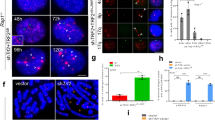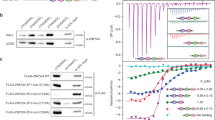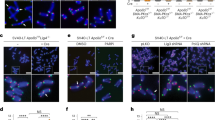Abstract
Progressive telomere attrition or uncapping of the shelterin complex elicits a DNA damage response as a result of a cell’s inability to distinguish dysfunctional telomeric ends from DNA double-strand breaks1. Telomere deprotection activates both ataxia telangiectasia mutated (ATM) and telangiectasia and Rad3-related (ATR) kinase-dependent DNA damage response pathways, and promotes efficient non-homologous end-joining (NHEJ) of dysfunctional telomeres2,3,4,5. The mammalian MRE11–RAD50–NBS1 (MRN; NBS1 is also known as NBN) complex interacts with ATM to sense chromosomal double-strand breaks and coordinate global DNA damage responses6,7. Although the MRN complex accumulates at dysfunctional telomeres, it is not known whether mammalian MRN promotes repair at these sites. Here we address this question by using mouse alleles that either inactivate the entire MRN complex or eliminate only the nuclease activities of MRE11 (ref. 8). We show that cells lacking MRN do not activate ATM when telomeric repeat binding factor 2 (TRF2) is removed from telomeres, and ligase 4 (LIG4)-dependent chromosome end-to-end fusions are markedly reduced. Residual chromatid fusions involve only telomeres generated by leading strand synthesis. Notably, although cells deficient for MRE11 nuclease activity efficiently activate ATM and recruit 53BP1 (also known as TP53BP1) to deprotected telomeres, the 3′ telomeric overhang persists to prevent NHEJ-mediated chromosomal fusions. Removal of shelterin proteins that protect the 3′ overhang in the setting of MRE11 nuclease deficiency restores LIG4-dependent chromosome fusions. Our data indicate a critical role for the MRN complex in sensing dysfunctional telomeres, and show that in the absence of TRF2, MRE11 nuclease activity removes the 3′ telomeric overhang to promote chromosome fusions. MRE11 can also protect newly replicated leading strand telomeres from NHEJ by promoting 5′ strand resection to generate POT1a–TPP1-bound 3′ overhangs.
This is a preview of subscription content, access via your institution
Access options
Subscribe to this journal
Receive 51 print issues and online access
$199.00 per year
only $3.90 per issue
Buy this article
- Purchase on Springer Link
- Instant access to full article PDF
Prices may be subject to local taxes which are calculated during checkout




Similar content being viewed by others
Change history
13 August 2009
Figure 3c was corrected on 13 August 2009.
References
Palm, W. & de Lange, T. How shelterin protects mammalian telomeres. Annu. Rev. Genet. 42, 301–334 (2008)
van Steensel, B., Smogorzewska, A. & de Lange, T. TRF2 protects human telomeres from end-to-end fusions. Cell 92, 401–413 (1998)
Celli, G. B. & de Lange, T. DNA processing is not required for ATM-mediated telomere damage response after TRF2 deletion. Nature Cell Biol. 7, 712–718 (2005)
Guo, X. et al. Dysfunctional telomeres activate an ATM-ATR-dependent DNA damage response to suppress tumorigenesis. EMBO J. 26, 4709–4719 (2007)
Denchi, E. L. & de Lange, T. Protection of telomeres through independent control of ATM and ATR by TRF2 and POT1. Nature 448, 1068–1071 (2007)
D’Amours, D. & Jackson, S. P. The Mre11 complex: at the crossroads of DNA repair and checkpoint signalling. Nature Rev. Mol. Cell Biol. 3, 317–327 (2002)
Lee, J. H. & Paull, T. T. ATM activation by DNA double-strand breaks through the Mre11-Rad50-Nbs1 complex. Science 308, 551–554 (2005)
Buis, J. et al. Mre11 nuclease activity has essential roles in DNA repair and genomic stability distinct from ATM activation. Cell 135, 85–96 (2008)
Falck, J., Coates, J. & Jackson, S. P. Conserved modes of recruitment of ATM, ATR and DNA-PKcs to sites of DNA damage. Nature 434, 605–611 (2005)
Deng, Y., Chan, S. S. & Chang, S. Telomere dysfunction and tumour suppression: the senescence connection. Nature Rev. Cancer 8, 450–458 (2008)
Zhu, X. D., Kuster, B., Mann, M., Petrini, J. H. & de Lange, T. Cell-cycle-regulated association of RAD50/MRE11/NBS1 with TRF2 and human telomeres. Nature Genet. 25, 347–352 (2000)
Takai, H., Smogorzewska, A. & de Lange, T. DNA damage foci at dysfunctional telomeres. Curr. Biol. 13, 1549–1556 (2003)
Zhu, X. D. et al. ERCC1/XPF removes the 3′ overhang from uncapped telomeres and represses formation of telomeric DNA-containing double minute chromosomes. Mol. Cell 12, 1489–1498 (2003)
O’Connor, M. S., Safari, A., Xin, H., Liu, D. & Songyang, Z. A critical role for TPP1 and TIN2 interaction in high-order telomeric complex assembly. Proc. Natl Acad. Sci. USA 103, 11874–11879 (2006)
Hockemeyer, D. et al. Telomere protection by mammalian Pot1 requires interaction with Tpp1. Nature Struct. Mol. Biol. 14, 754–761 (2007)
Hockemeyer, D., Daniels, J. P., Takai, H. & de Lange, T. Recent expansion of the telomeric complex in rodents: Two distinct POT1 proteins protect mouse telomeres. Cell 126, 63–77 (2006)
Wu, L. et al. Pot1 deficiency initiates DNA damage checkpoint activation and aberrant homologous recombination at telomeres. Cell 126, 49–62 (2006)
Hockemeyer, D., Palm, W., Wang, R. C., Couto, S. S. & de Lange, T. Engineered telomere degradation models dyskeratosis congenita. Genes Dev. 22, 1773–1785 (2008)
He, H. et al. Pot1b deletion and telomerase haploinsufficiency in mice initiate an ATR-dependent DNA damage response and elicit phenotypes resembling dyskeratosis congenita. Mol. Cell. Biol. 29, 229–240 (2009)
Dimitrova, N., Chen, Y. C., Spector, D. L. & de Lange, T. 53BP1 promotes non-homologous end joining of telomeres by increasing chromatin mobility. Nature 456, 524–528 (2008)
Bailey, S. M., Cornforth, M. N., Kurimasa, A., Chen, D. J. & Goodwin, E. H. Strand-specific postreplicative processing of mammalian telomeres. Science 293, 2462–2465 (2001)
Hopkins, B. B. & Paull, T. T. The P. furiosus MRE11/RAD50 complex promotes 5′ strand resection at a DNA double-strand break. Cell 135, 250–260 (2008)
Limbo, O. et al. Ctp1 is a cell-cycle-regulated protein that functions with Mre11 complex to control double-strand break repair by homologous recombination. Mol. Cell 28, 134–146 (2007)
Sartori, A. A. et al. Human CtIP promotes DNA end resection. Nature 450, 509–514 (2007)
Mimitou, E. P. & Symington, L. S. Sae2, Exo1 and Sgs1 collaborate in DNA double-strand break processing. Nature 455, 770–774 (2008)
Zhu, Z., Chung, W. H., Shim, E. Y., Lee, S. E. & Ira, G. Sgs1 helicase and two nucleases Dna2 and Exo1 resect DNA double-strand break ends. Cell 134, 981–994 (2008)
Paull, T. T. & Gellert, M. The 3′ to 5′ exonuclease activity of Mre11 facilitates repair of DNA double-strand breaks. Mol. Cell 1, 969–979 (1998)
Dinkelmann, M. et al. Multiple functions of MRN in end-joining pathways during isotype class switching. Nature Struct. Mol. Biol. (in the press)
Wang, X. & Baumann, P. Chromosome fusions following telomere loss are mediated by single-strand annealing. Mol. Cell 31, 463–473 (2008)
Verdun, R. E. & Karlseder, J. The DNA damage machinery and homologous recombination pathway act consecutively to protect human telomeres. Cell 127, 709–720 (2006)
Acknowledgements
We are grateful to M. Zhao, Z. Lu, P. Iyengar and J. Buis for technical help. Both J. Karlseder and P. Carpenter are thanked for providing antibodies. S.C. acknowledges financial support from the National Institute on Aging (NIA) (RO1 AG028888), the National Cancer Institute (NCI) (RO1 CA129037), the Welch Foundation, the Susan G. Koman Race for the Cure Foundation, the Abraham and Phyllis Katz Foundation and the Michael Kadoorie Cancer Genetic Research Program. Y.D. was supported by an NCI Howard Temin Award (K01CA124461).
Author Contributions Y.D. designed and guided all experiments, helped write the paper and generated figures. X.G. performed all the experiments presented. D.O.F. provided MRE11 mouse cell lines for this study and assisted in the interpretation of results. S.C. conceived this study, analysed and interpreted the data, wrote the paper and finalized the figures.
Author information
Authors and Affiliations
Corresponding author
Supplementary information
Supplementary Information
This file contains Supplementary Figures S1-S12 with Legends and Supplementary Tables S1-S2. (PDF 1090 kb)
Rights and permissions
About this article
Cite this article
Deng, Y., Guo, X., Ferguson, D. et al. Multiple roles for MRE11 at uncapped telomeres. Nature 460, 914–918 (2009). https://doi.org/10.1038/nature08196
Received:
Accepted:
Published:
Issue Date:
DOI: https://doi.org/10.1038/nature08196
This article is cited by
-
Homology directed telomere clustering, ultrabright telomere formation and nuclear envelope rupture in cells lacking TRF2B and RAP1
Nature Communications (2023)
-
Distinct functions of POT1 proteins contribute to the regulation of telomerase recruitment to telomeres
Nature Communications (2021)
-
Inhibition of MRN activity by a telomere protein motif
Nature Communications (2021)
-
Monogenic and polygenic inheritance become instruments for clonal selection
Nature (2020)
-
Microcephalin 1/BRIT1-TRF2 interaction promotes telomere replication and repair, linking telomere dysfunction to primary microcephaly
Nature Communications (2020)
Comments
By submitting a comment you agree to abide by our Terms and Community Guidelines. If you find something abusive or that does not comply with our terms or guidelines please flag it as inappropriate.



